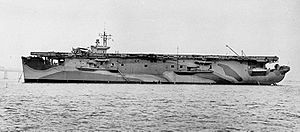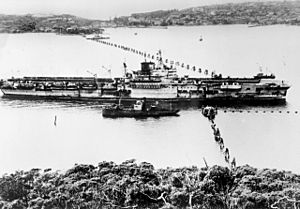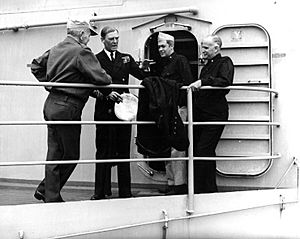Philip Vian facts for kids
Quick facts for kids
Sir Philip Louis Vian
|
|
|---|---|

Sir Philip Vian
|
|
| Born | 14 June 1894 London, England |
| Died | 27 May 1968 (aged 73) Ashford Hill, Hampshire, England |
| Allegiance | United Kingdom |
| Service/ |
Royal Navy |
| Years of service | 1907–1952 |
| Rank | Admiral of the Fleet |
| Commands held | Home Fleet 1st Aircraft Carrier Squadron 15th Cruiser Squadron Force K HMS Cossack HMS Ganges HMS Arethusa HMS Douglas HMS Active |
| Battles/wars | |
| Awards |
|
| Other work | Director, Midland Bank (1952); Director, North British and Mercantile Insurance Co. Published: Action this day (1960) |
Admiral of the Fleet Sir Philip Louis Vian (born July 15, 1894 – died May 27, 1968) was a high-ranking officer in the Royal Navy. He served bravely in both the First World War and the Second World War.
Vian was an expert in naval gunnery, which is the use of naval guns. He commanded several destroyers, which are fast warships. One famous moment was when he rescued British sailors from a German ship called Altmark in Norway. He also played a key role in the final battle against the German battleship Bismarck.
During World War II, Vian spent much time in the Mediterranean Sea. He protected important supply convoys and supported Allied invasions in Sicily and Italy. Later, he led the air forces of the British Pacific Fleet against Japan. After the war, he continued to serve in important roles before retiring in 1952 as an Admiral of the Fleet.
Contents
Philip Vian was born in London, England, on June 14, 1894. He joined the Royal Navy as a cadet in May 1907. He studied at the Royal Naval Colleges at Osborne and Dartmouth.
In 1911, Vian finished his training at Dartmouth. He then sailed to the West Indies on the training ship HMS Cornwall. In January 1912, he became a midshipman on the battleship HMS Lord Nelson.
Serving in the First World War
When the First World War began, Vian was still on HMS Lord Nelson. This ship was older and kept away from the main fighting. This was disappointing for Vian, who wanted more action.
From October 1914 to September 1915, Vian served on HMS Argonaut. This ship patrolled off East Africa, looking for a German cruiser. He became a sub-lieutenant in January 1915.
Vian then moved to HMS Morning Star, a modern destroyer, in October 1915. He was present at the Battle of Jutland, but his ship did not take part in the fighting. He was promoted to lieutenant in 1917. He then served as First Lieutenant on the destroyers HMS Ossory and HMS Sorceress.
Between the World Wars
After the First World War, Vian became a gunnery expert. He worked at the Royal Naval gunnery school. In January 1920, he was loaned to the Royal Australian Navy. He served as the Gunnery Officer on HMAS Australia.
When he returned to the Royal Navy, Vian continued as a gunnery officer. He served on battleships like HMS Thunderer and cruisers like HMS Champion. He was promoted to lieutenant-commander in February 1924.
In 1927, he served on HMS Kent, the main ship of the China Station. He was promoted to commander in June 1929. For two years, he worked at the British Admiralty in London. He analyzed gunnery statistics.
In March 1933, Vian took his first command, the destroyer HMS Active. He also led a division within the 3rd Destroyer Flotilla. During this time, he met the famous playwright Noël Coward in Bermuda.
Vian was promoted to captain in December 1934. He then commanded the 19th Destroyer Flotilla. His ships helped protect British residents during the start of the Spanish Civil War. In March 1937, he became the Flag-Captain of HMS Arethusa.
Second World War Service
Just before the Second World War began, Vian returned to the UK. He was given command of the 11th Destroyer Flotilla. This group of ships escorted convoys across the Atlantic. Later, he commanded the famous 4th Destroyer Flotilla. His ship was HMS Cossack.
The Altmark Incident
In February 1940, Vian's ships were ordered to find the German supply ship Altmark. This ship was believed to hold about 300 captured British merchant sailors. Altmark was found in neutral Norwegian waters.
Vian pursued Altmark into a fjord, a narrow inlet of the sea. His crew boarded the ship and freed the captives. This event was widely reported in Britain.
Germany invaded Norway in April 1940. Vian, now on HMS Afridi, fought against German ships and supported Allied troops. On May 3, Afridi was bombed and sunk while rescuing survivors. Vian was recognized for his actions.
In October, Vian, back on HMS Cossack, attacked a German convoy. He received an award for this action.
In May 1941, Vian's destroyers joined the hunt for the German battleship Bismarck. His ships attacked Bismarck at night. They didn't hit the ship, but their attacks kept the German crew from resting. This helped the main British fleet destroy Bismarck the next day. Vian received another award for his part in this battle.
Vian was promoted to rear admiral in July 1941. In September, he commanded Force K. This naval force supported a raid on Spitsbergen, Norway. They destroyed coal mines and evacuated Russian miners. During their return, they sank a German training ship.
Battles in the Mediterranean
In October 1941, Vian took command of the 15th Cruiser Squadron. His main job was to protect supply convoys to Malta. Malta was a British base that needed supplies to survive. He also supported Allied military actions in North Africa.
In December 1941, Vian's first convoy led to the First Battle of Sirte. This was a series of fights between British and Italian warships. Both sides managed to deliver their supplies.
In March 1942, Vian's flagship, HMS Naiad, was sunk by a German submarine. Vian moved to another ship. Later that month, the Second Battle of Sirte took place. Vian's force held off a much larger Italian fleet. This allowed the convoy to escape. Although the supply ships were later sunk by air attacks, Vian was praised for his bravery. He was made a Knight Commander of the Most Excellent Order of the British Empire (KBE).
Vian's health suffered, and he returned to Britain in September 1942. He recovered and was recognized for his "devotion to duty."
In July 1943, Vian returned to the Mediterranean. He commanded a force for the Allied invasion of Sicily. In September 1943, he led Force V. This group of escort aircraft carriers provided air support for the Allied landings at Salerno, Italy. Vian was recognized twice for his service in Italy.
Normandy Landings
In November 1943, Vian returned to the UK to prepare for D-Day. In January 1944, he commanded the Eastern Task Force. This force supported the D-Day landings in Normandy. He received more honors for his planning and execution of the successful landings.
British Pacific Fleet Operations
In November 1944, Vian became the commander of air operations for the British Pacific Fleet. His first missions were against Japanese oil and port facilities in Sumatra. These attacks damaged enemy capabilities and provided training for the British crews.
The British Pacific Fleet then joined the American forces. They provided air support for the American invasion of Okinawa in March 1945. Their role was to stop Japanese air operations in the Sakishima Islands. Vian was promoted to vice admiral in May 1945.
After the War
After Japan surrendered, Vian returned to the UK. From 1946 to 1948, he was the Fifth Sea Lord. This role put him in charge of naval aviation. He was promoted to admiral in 1948.
His final role was Commander in Chief of the Home Fleet. He served in this position until his retirement in 1952. He was promoted to Admiral of the Fleet in June 1952. This is a very high rank, rarely given to officers who were not First Sea Lord.
Vian received many awards and honors throughout his career. He was mentioned in official reports five times for his outstanding service.
In retirement, Vian became a director for the Midland Bank and an insurance company. He also wrote his memoirs, called Action This Day, in 1960. He passed away on May 27, 1968, at his home in Hampshire.
Family Life
Philip Vian married Marjorie Haig on December 2, 1929. They had two daughters together.
Honours and Awards
Sir Philip Vian received many important honors for his service:
| Knight Grand Cross of the Order of the Bath | 1952 | |
| Knight Commander of the Order of the Bath | 1944 | |
| Companion of the Order of the Bath | 1944 | |
| Knight Commander of the Order of the British Empire | 1942 | |
| Distinguished Service Order and two bars | 1940, 1940, 1941 | |
| Légion d'honneur (France) | ||
| Croix de Guerre 1939–1945 (France) | ||
| Legion of Merit, Degree of Commander (United States) | 1945 | |
| Navy Distinguished Service Medal (United States) | 1946 | |
| St. Olav's Medal With Oak Branch (Norway) | 1948 | |
| Order of the Dannebrog (Denmark) |
See also
- List of Legion of Honour recipients by name (V)






